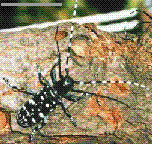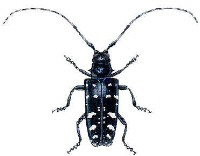
A serious threat to our woodlands has arrived in Toronto. It has been in New York and Chicago for several years. It could devastate Ontario’s southern forests; a forest that is only a fragment of what it was originally. Like the chestnut blight and Dutch elm disease, the Asian longhorned beetle has the potential to drastically change our woodlands. It was discovered in this area in September, but it is likely that this infestation started here several years ago. Unlike many other pests, this insect can attack and infest virtually any species of deciduous (i.e. hardwood) tree. It has no known natural predators or controls in North America. Deciduous trees at risk from this insect include all species of maple along with poplars, willows, birch, elm, ash, horsechestnut, alder, linden, and various fruit trees. In fact all hardwoods should be considered at risk.
Rapid and drastic action is required if we have any chance of containing it. Control measures must include the removal of infected trees, sanitation belts around. That means removal of many uninfected deciduous trees in areas of infestation. All the wood will have to be burnt or buried. Residents in affected areas have been asked not to move any tree materials (including nursery stock, firewood, and fallen or pruned branches) from the infested areas.”
In parts of our city our street trees, our backyard trees, our park trees and woodlands will have to be sacrificed in the battle to eradicate the beetle. While this measure will appear to be a very cruel cut, the survival of much of our remaining hardwood woodlands could be lost it this action is not taken.


This beetle has a large shiny black body (35 mm long and 12 mm wide maximum size) with up to 20 white dots; Adults have two long antennae composed of 11 segments. Each segment is black with a whitish ring at the base.
The signs of attack on trees include: exit holes in bark. 1 cm across and sawdust on branches or tree base.
Please call 1-800-442-2342 to notify Canadian Food Inspection Agency authorities if you think you have found the beetle in your area. For more information, visit the CFIA website.
